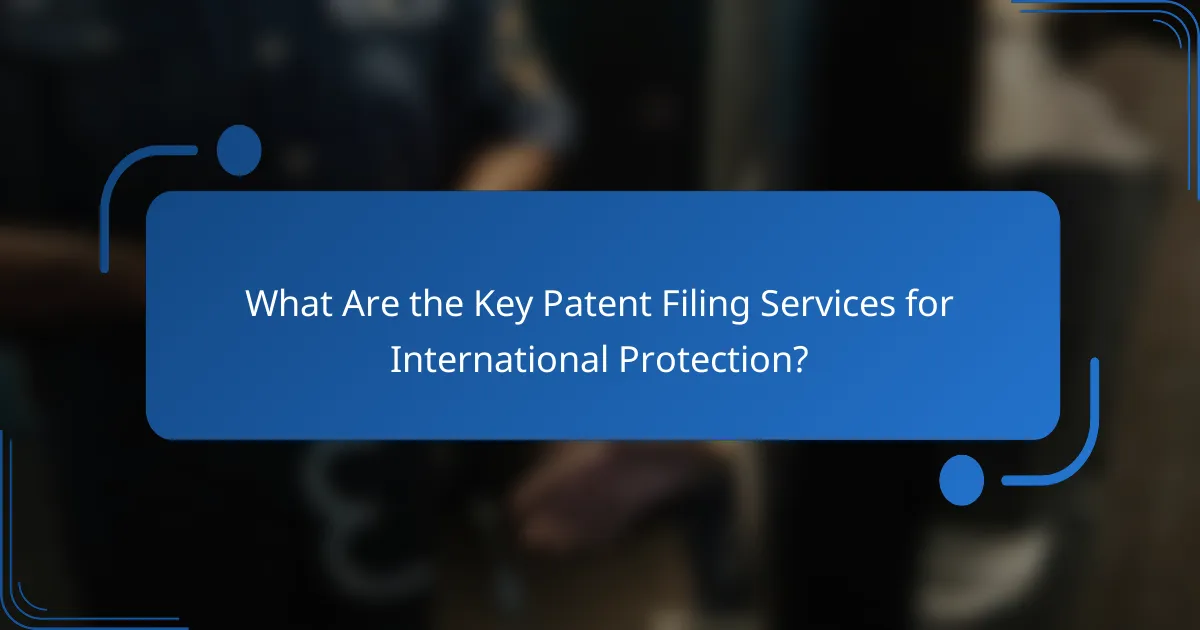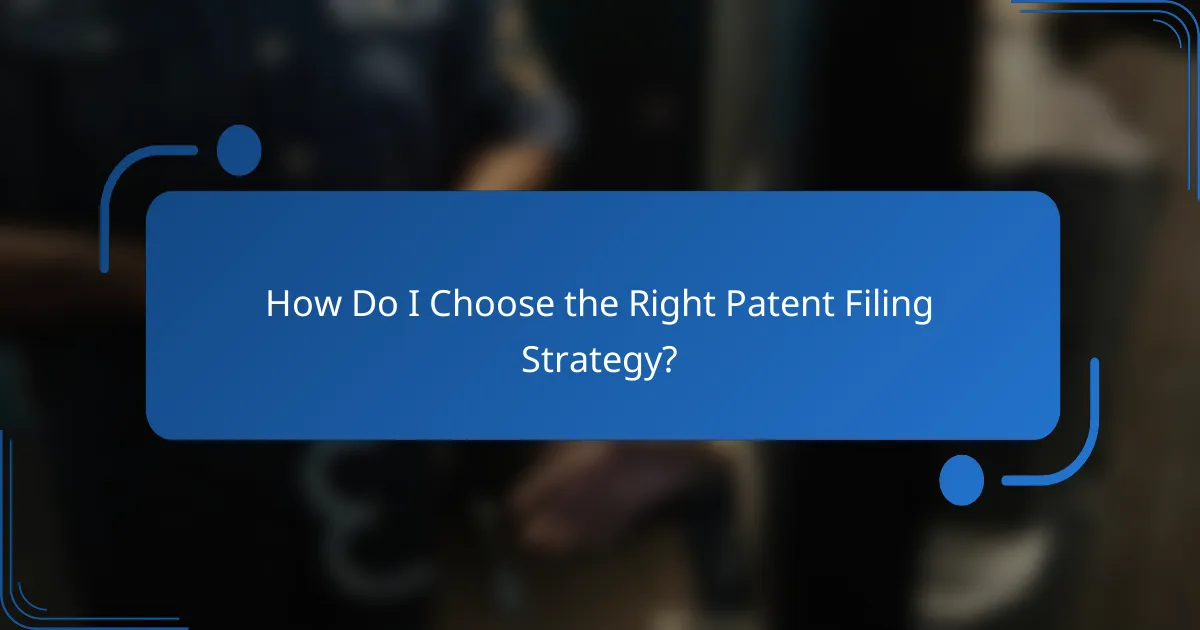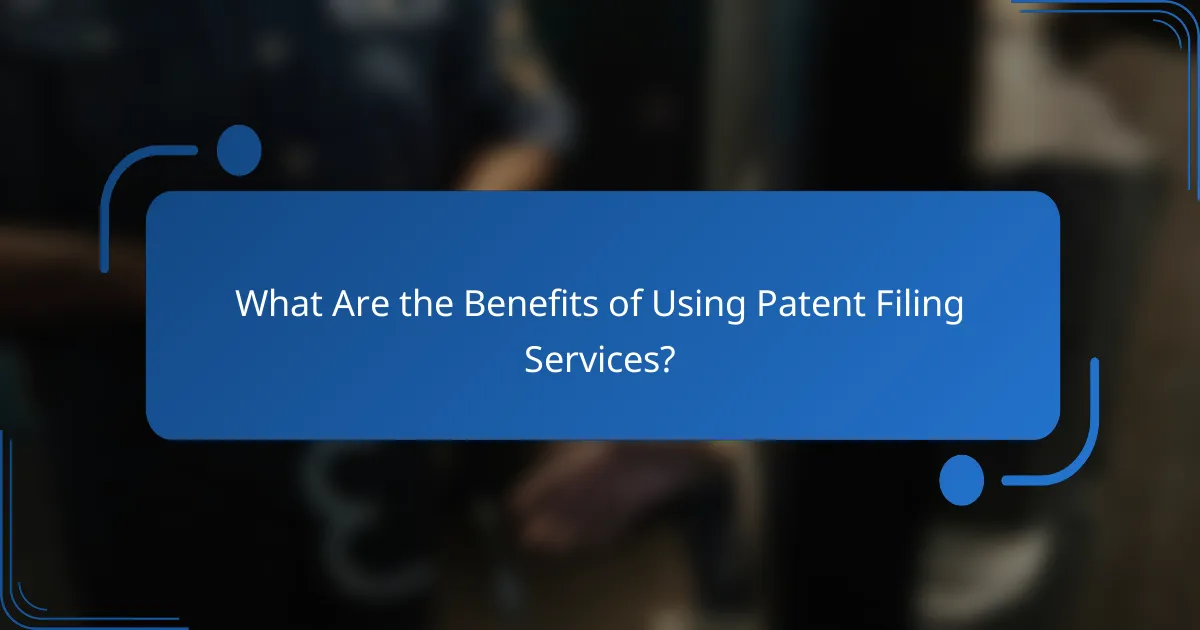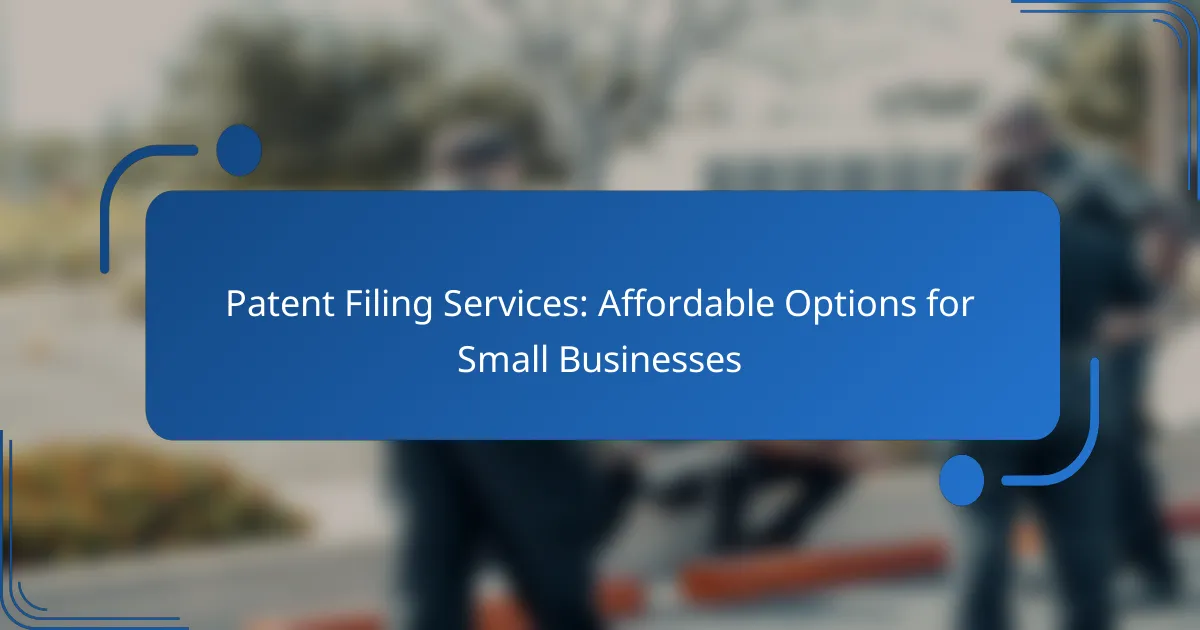Patent filing services for international protection are essential for inventors seeking to secure their intellectual property rights across various jurisdictions. These services facilitate a streamlined filing process, ensuring compliance with diverse legal frameworks while maximizing protection. By carefully evaluating market needs and potential jurisdictions, inventors can develop effective strategies that optimize resources and enhance their global patent portfolio.

What Are the Key Patent Filing Services for International Protection?
Key patent filing services for international protection include strategies that help inventors secure their intellectual property rights across multiple jurisdictions. These services streamline the process of filing patents globally, ensuring compliance with various legal frameworks and maximizing protection.
Global Patent Filing
Global patent filing involves submitting patent applications in multiple countries to protect inventions worldwide. This process can be complex due to differing laws and regulations in each jurisdiction. Utilizing a centralized service can simplify this, allowing inventors to manage their filings more efficiently.
When considering global patent filing, it’s essential to evaluate the countries where protection is most needed based on market potential and competition. Costs can vary significantly, often ranging from a few thousand to tens of thousands of dollars depending on the number of countries and the complexity of the invention.
Patent Cooperation Treaty (PCT) Services
PCT services facilitate a unified process for filing patents in multiple countries through a single application. This treaty allows inventors to delay the costs of national filings while securing an international filing date. The PCT process typically takes about 30 months from the initial filing to national phase entry.
Using PCT services can be advantageous for startups and small businesses, as it provides a strategic window to assess market viability before committing to expensive national filings. However, applicants must still be aware of the specific requirements and deadlines for each country they wish to enter.
National Phase Entry Services
National phase entry services refer to the process of transitioning from a PCT application to individual national filings. This step is crucial for obtaining patent protection in specific countries after the international phase. Each country has its own deadlines and requirements for national phase entry, typically within 30 months of the PCT filing date.
It’s important to prepare for potential translation and legal fees during this phase, which can vary widely. Engaging a local patent attorney can help navigate these complexities and ensure compliance with local laws.
Regional Patent Systems
Regional patent systems allow inventors to file a single application that provides protection across multiple countries within a specific region. Examples include the European Patent Office (EPO) for Europe and the African Regional Intellectual Property Organization (ARIPO). These systems can reduce costs and simplify the filing process.
When utilizing regional patent systems, applicants should consider the coverage area and the specific regulations of the regional office. Fees can be more economical than filing separately in each member country, but understanding the nuances of each system is essential for effective protection.
Patent Prosecution Services
Patent prosecution services involve the legal process of obtaining a patent, including responding to office actions and negotiating with patent examiners. This service is critical for addressing any objections or rejections that may arise during the examination process. Effective communication with patent offices can significantly influence the outcome of an application.
Engaging experienced patent prosecution professionals can enhance the chances of successful patent grants. It’s advisable to prepare thorough documentation and be proactive in addressing any issues raised by patent examiners to avoid delays and additional costs.

How Do I Choose the Right Patent Filing Strategy?
Choosing the right patent filing strategy involves understanding your market needs, evaluating potential jurisdictions, and conducting a cost-benefit analysis. A well-planned approach can help you secure international protection effectively while optimizing resources.
Assessing Market Needs
Begin by identifying the markets where your invention will have the most impact. Consider factors such as market size, competition, and consumer demand. This assessment will guide your decision on where to file patents to maximize your investment.
For instance, if your product targets the European market, prioritize filing in key EU countries like Germany, France, and the UK. This focus ensures that your patent protection aligns with your business strategy and market entry plans.
Evaluating Patent Jurisdictions
Different jurisdictions have varying patent laws, filing processes, and enforcement mechanisms. Research the specific requirements and advantages of each region, such as the United States, Europe, or Asia-Pacific countries. Understanding these nuances can help you select the most favorable jurisdictions for your patent filings.
For example, the United States offers a first-to-file system, while many European countries follow a similar approach but may have additional requirements. Assessing these differences will help you navigate the complexities of international patent law.
Cost-Benefit Analysis
Conduct a thorough cost-benefit analysis to weigh the expenses of filing patents against the potential returns. Consider filing fees, attorney costs, and maintenance fees in various jurisdictions. This analysis will help you prioritize where to invest your resources effectively.
For instance, filing a patent in the US can range from a few thousand to tens of thousands of USD, depending on the complexity of the application. Compare this with the costs in other regions, such as Europe, where fees may vary significantly. Make informed decisions based on your budget and anticipated market success.

What Are the Costs Involved in International Patent Filing?
The costs of international patent filing can vary significantly based on factors such as the jurisdictions involved, the complexity of the invention, and the services required. Generally, these costs can be categorized into filing fees, attorney fees, and maintenance costs, each of which plays a crucial role in the overall expense of securing international patent protection.
Filing Fees Overview
Filing fees are the initial costs associated with submitting a patent application in various countries. These fees can range from a few hundred to several thousand dollars, depending on the country and the type of application (e.g., provisional or non-provisional). For instance, the European Patent Office (EPO) may charge around €1,500 for a standard application, while fees in the United States can start at approximately $300.
It’s essential to consider additional fees that may apply, such as those for extra claims or pages. Some jurisdictions may also have reduced fees for small entities or individuals, which can help lower the overall cost.
Attorney Fees for Patent Services
Attorney fees for patent services can be one of the most significant expenses in the patent filing process. These fees typically range from $5,000 to $15,000 or more, depending on the complexity of the invention and the attorney’s experience. Engaging a qualified patent attorney is crucial, as they can help navigate the intricacies of international patent law and ensure that applications meet specific requirements.
When selecting an attorney, consider their expertise in your industry and their familiarity with the patent systems in the countries where you seek protection. This can save time and reduce the likelihood of costly mistakes during the filing process.
Maintenance Costs
Maintenance costs are ongoing fees required to keep a patent in force once granted. These costs can vary widely by jurisdiction, with some countries requiring annual fees that can range from a few hundred to several thousand dollars. For example, in the United States, maintenance fees for a utility patent can total around $12,000 over the life of the patent.
It’s important to budget for these maintenance costs as part of your overall patent strategy. Failing to pay these fees can result in the loss of patent rights, so tracking deadlines and costs is essential for maintaining international patent protection.

What Are the Benefits of Using Patent Filing Services?
Using patent filing services offers significant advantages, including expert assistance, time savings, and higher chances of approval. These services help inventors navigate complex legal requirements and streamline the application process, ensuring better protection for their intellectual property.
Expert Guidance
Patent filing services provide access to professionals with extensive knowledge of patent law and regulations. These experts can help identify the most suitable type of patent for your invention, whether it’s a utility, design, or plant patent.
They also assist in drafting the patent application, ensuring that it meets all legal requirements and effectively communicates the invention’s uniqueness. This guidance is crucial, as a poorly written application can lead to delays or rejections.
Time Efficiency
Filing a patent can be a time-consuming process, often taking months or even years. Patent filing services streamline this process by managing timelines and deadlines, allowing inventors to focus on their core business activities.
By leveraging their experience, these services can expedite the preparation and submission of applications, reducing the overall time to secure patent protection. This efficiency is particularly important in fast-paced industries where time-to-market can be critical.
Increased Success Rates
Utilizing patent filing services can significantly improve the likelihood of a successful application. Experts understand common pitfalls and can help avoid mistakes that often lead to rejections.
Studies suggest that applications prepared by professionals have higher approval rates compared to those submitted by individuals without legal expertise. This increase in success rates can save inventors both time and money in the long run.

What Are the Common Challenges in International Patent Filing?
International patent filing presents several challenges, including navigating diverse legal systems, varying costs, and differing timelines. Understanding these obstacles is crucial for effective protection of intellectual property across borders.
Complexity of Different Legal Systems
Each country has its own patent laws and procedures, making it difficult to ensure compliance across jurisdictions. For instance, the requirements for patentability can differ significantly; what is patentable in one country may not be in another. This complexity necessitates thorough research and possibly local legal expertise.
High Costs of Filing and Maintenance
The financial burden of international patent filing can be substantial. Costs may include filing fees, translation expenses, and attorney fees, which can range from a few thousand to tens of thousands of dollars depending on the number of countries involved. Budgeting for both initial filings and ongoing maintenance fees is essential for long-term protection.
Time-Consuming Processes
International patent applications can take several years to process, with timelines varying by country. Delays can occur due to administrative backlogs or the need for additional documentation. Applicants should plan for these extended timelines and consider filing strategies that may expedite the process, such as utilizing the Patent Cooperation Treaty (PCT).
Risk of Inconsistent Protection
Filing in multiple jurisdictions does not guarantee uniform protection, as enforcement can vary widely. Some countries may have weaker enforcement mechanisms, making it challenging to defend patents effectively. It is advisable to assess the enforcement landscape in each target market before proceeding with filings.



